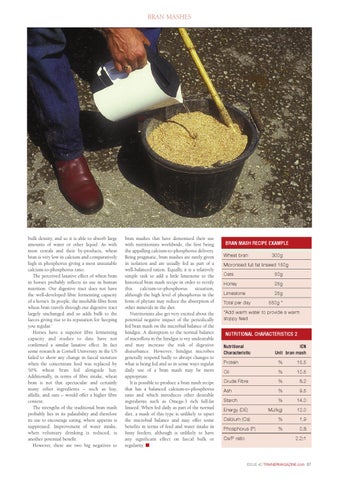BRAN MASH ISSUE 40_Jerkins feature.qxd 30/11/2012 15:44 Page 2
BRAN MASHES
bulk density, and so it is able to absorb large amounts of water or other liquid. As with most cereals and their by-products, wheat bran is very low in calcium and comparatively high in phosphorus giving a most unsuitable calcium-to-phosphorus ratio. The perceived laxative effect of wheat bran in horses probably reflects its use in human nutrition. Our digestive tract does not have the well-developed fibre fermenting capacity of a horse’s. In people, the insoluble fibre from wheat bran travels through our digestive tract largely unchanged and so adds bulk to the faeces giving rise to its reputation for ‘keeping you regular.’ Horses have a superior fibre fermenting capacity and studies to date have not confirmed a similar laxative effect. In fact some research at Cornell University in the US failed to show any change in faecal moisture when the concentrate feed was replaced by 50% wheat bran fed alongside hay. Additionally, in terms of fibre intake, wheat bran is not that spectacular and certainly many other ingredients – such as hay, alfalfa, and oats – would offer a higher fibre content. The strengths of the traditional bran mash probably lies in its palatability and therefore its use to encourage eating, where appetite is suppressed. Improvement of water intake, when voluntary drinking is reduced, is another potential benefit. However, there are two big negatives to
bran mashes that have demonised their use with nutritionists worldwide, the first being the appalling calcium-to-phosphorus delivery. Being pragmatic, bran mashes are rarely given in isolation and are usually fed as part of a well-balanced ration. Equally, it is a relatively simple task to add a little limestone to the historical bran mash recipe in order to rectify this calcium-to-phosphorus situation, although the high level of phosphorus in the form of phytate may reduce the absorption of other minerals in the diet. Nutritionists also get very excited about the potential negative impact of the periodically fed bran mash on the microbial balance of the hindgut. A disruption to the normal balance of microflora in the hindgut is vey undesirable and may increase the risk of digestive disturbance. However, hindgut microbes generally respond badly to abrupt changes to what is being fed and so in some ways regular daily use of a bran mash may be more appropriate. It is possible to produce a bran mash recipe that has a balanced calcium-to-phosphorus ratio and which introduces other desirable ingredients such as Omega-3 rich full-fat linseed. When fed daily as part of the normal diet, a mash of this type is unlikely to upset the microbial balance and may offer some benefits in terms of feed and water intake in fussy feeders, although is unlikely to have any significant effect on faecal bulk or regularity. n
BRAN MASH RECIPE EXAMPLE Wheat bran
300g
Micronised full fat linseed 150g Oats
50g
Honey
25g
Limestone
25g
Total per day
550g *
*Add warm water to provide a warm sloppy feed
NUTRITIONAL CHARACTERISTICS 2 Nutritional Characteristic
IEN Unit bran mash
Protein
%
15.5
Oil
%
10.5
Crude Fibre
%
8.2
Ash
%
9.5
Starch
%
14.0
MJ/kg)
12.0
Calcium (Ca)
%
1.9
Phosphorus (P)
%
0.8
Energy (DE)
Ca/P ratio
2.2:1
ISSUE 40 TRAINERMAGAZINE.com 57
